The Tree Climbing Lions in Uganda are part of the wider lion family – The largest cats still roaming the African wild. Lions in general help balance the eco-system by maintaining the population of herbivores animals like Buffaloes and the different species of antelopes. Lions also prey on weaker and sick animals helping reduce the spread of diseases and parasites. Unfortunately the overall population of lions in Africa has reduced considerably with about 25,000 individuals lions still living in the wild. Over 1 million lions roamed Africa’s savanna just a century ago.
One important fact about lions is that the main cause of their massive reduction in number is human 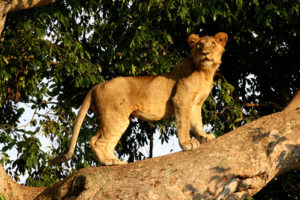 interference. Increased human population has seen lion territory reduce as more land is cleared for farming and settlement. Lions have also fallen victims to poaching and new diseases brought by more domestic animals within their vicinity.
interference. Increased human population has seen lion territory reduce as more land is cleared for farming and settlement. Lions have also fallen victims to poaching and new diseases brought by more domestic animals within their vicinity.
Uganda is one of the last strongholds for lions in Africa. Lions can be sighted in Queen Elizabeth National Park, Murchison Falls National Park and Kidepo Valley National Park. Of the about 400 lions in Uganda, 130 are found in Queen Elizabeth National Park – the most visited park in Uganda. The park receives good rains and retains its scenic beauty for most parts of the year unlike say the drier Maraa in Kenya. The park also stands out because of its amazing landscape (Maramagambo forest, Kazinga Channel, craters and Kyambura gorge), birding population and wildlife – especially the rare tree climbing lion which are one of the leading tourist attractions in Uganda. You might want to read about the best places to see lions in the world.
Where to see tree climbing lions in Africa
Adult Tree climbing lions are very rare. Most lions keep away from trees once they reach a certain size, except when surrounded by say a herd of buffalo and climbing a tree is the only safety option. Tree climbing lions are mainly found in the Ishasha sector of Uganda’s Queen Elizabeth National park and Lake Manyara National Park in Tanzania. Individual lions have also been sighted climbing trees in the Serengeti National Park in Tanzania and Kruger National Park in South Africa. However these are rare sightings and cannot be compared to those in Queen Elizabeth National Park or Lake Manyara. In Ishasha, a whole prides can be spotted on a tree making Queen Elizabeth National Park the best place to spot tree climbing lions. The tree climbing lions in Lake Manyara are more difficult to locate and finding them is not guaranteed. Please check out our Congo safari packages for more information about visiting one Africa’s last remaining true wildernesses. We have also put together Rwanda tour packages with information about the land of Mountain gorillas, volcanoes and beautiful hills.
Why do some lions climb trees?
Most lions prefer staying on the ground and leave tree climbing for their cubs or other smaller cats like Leopards. The lions in Lake Manyara and Queen Elizabeth National parks have however deviated from usual behavior and can be seen lazing around acacia and fig trees in the early afternoon. Why do they do this yet they are not a unique sub-specie? Several theories that have been proposed to explain this unique behavior. 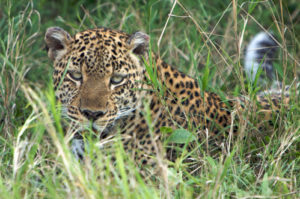 Some people believe that lions have a natural ability to climb trees like all cats. Climbing trees should therefore not be a surprise given that like all cats, they have sharp claws. Others believe that the lions in Ishasha have adapted this behavior from countless generations of lion prides before them. Some lion researchers believe that the lions climb trees to avoid bites from pests and insects like Tse Tse flies and mosquitoes that live on lower ground. The researchers also believe the lions climb trees to escape the midday heat on the ground especially during the dry season. The leaves and tree branches offer a cool breeze and relief from the great afternoon heat. By climbing to the top of the fig and acacia trees, the lions can get uninterrupted rest while also monitoring their territories for prey and other their competitors like hyenas and leopards. Whatever the reasons for the intriguing habit of climbing trees, the lions attract more and more visitors each year to Queen Elizabeth and Lake Manyara National Park.
Some people believe that lions have a natural ability to climb trees like all cats. Climbing trees should therefore not be a surprise given that like all cats, they have sharp claws. Others believe that the lions in Ishasha have adapted this behavior from countless generations of lion prides before them. Some lion researchers believe that the lions climb trees to avoid bites from pests and insects like Tse Tse flies and mosquitoes that live on lower ground. The researchers also believe the lions climb trees to escape the midday heat on the ground especially during the dry season. The leaves and tree branches offer a cool breeze and relief from the great afternoon heat. By climbing to the top of the fig and acacia trees, the lions can get uninterrupted rest while also monitoring their territories for prey and other their competitors like hyenas and leopards. Whatever the reasons for the intriguing habit of climbing trees, the lions attract more and more visitors each year to Queen Elizabeth and Lake Manyara National Park.
The Ishasha Sector of Queen Elizabeth National Park
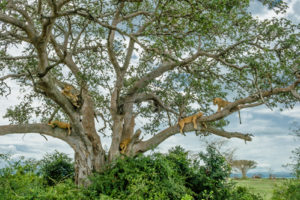 The remote Ishasha plains are remarkably different from other sectors of Queeen Elizabeth National Park. The plains consist of mainly savanna grasslands and riverine forests. It is a testament to the variety of attractions in Queen Elizabeth National Park that few visitors actually go to see the tree climbing lions of Ishasha. Most visitors to the Park visit the Mweya and Kasenyi plains were they can easily go for game drives, boat cruises along the Kazinga channel, chimpanzee tracking in Kyambura Gorge or taking a nature walk in the Maramagambo forest. They are usually satisfied after spotting the common lion prides in the Kasenyi sector. One reason for the fewer visitors could be the lack of information about the existence of these unique cats. Many of the parks visitors only get to know about them when they are already on a planned safari. Squeezing time within a planned safari to go and see the tree climbing lions can be difficult.
The remote Ishasha plains are remarkably different from other sectors of Queeen Elizabeth National Park. The plains consist of mainly savanna grasslands and riverine forests. It is a testament to the variety of attractions in Queen Elizabeth National Park that few visitors actually go to see the tree climbing lions of Ishasha. Most visitors to the Park visit the Mweya and Kasenyi plains were they can easily go for game drives, boat cruises along the Kazinga channel, chimpanzee tracking in Kyambura Gorge or taking a nature walk in the Maramagambo forest. They are usually satisfied after spotting the common lion prides in the Kasenyi sector. One reason for the fewer visitors could be the lack of information about the existence of these unique cats. Many of the parks visitors only get to know about them when they are already on a planned safari. Squeezing time within a planned safari to go and see the tree climbing lions can be difficult.
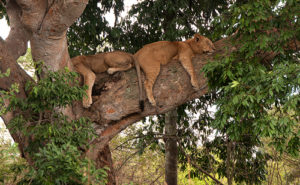 There are four prides of lions living within the Ishasha plains. About 50 individuals are estimated to be living within the four main prides. The lions love climbing the common acacia and large sycamore fig trees in the plains especially during the dry seasons. Because entire prides spend their day on top of trees, the chances of seeing the lions in Ishasha are very high. The park authorities monitor their movements and can easily track them on request. Visiting the tree climbing lions of Ishasha can be arranged alongside an overall safari of Queen Elizabeth national park and other nearby parks like Bwindi impenetrable forest and Lake Mburo. You can read more from our 3 days Uganda gorilla safari or the longer 12 Days Uganda safari package.
There are four prides of lions living within the Ishasha plains. About 50 individuals are estimated to be living within the four main prides. The lions love climbing the common acacia and large sycamore fig trees in the plains especially during the dry seasons. Because entire prides spend their day on top of trees, the chances of seeing the lions in Ishasha are very high. The park authorities monitor their movements and can easily track them on request. Visiting the tree climbing lions of Ishasha can be arranged alongside an overall safari of Queen Elizabeth national park and other nearby parks like Bwindi impenetrable forest and Lake Mburo. You can read more from our 3 days Uganda gorilla safari or the longer 12 Days Uganda safari package.
How to reach Ishasha sector of Queen Elizabeth National Park
One can reach the Ishasha sector of Queen Elizabeth by road or air. There is an airstrip in Ishasha offering the opportunity to take a chartered flight from Entebbe international airport or Kajjansi in Kampala directly to the park. Those who wish to marvel at the Ugandan countryside and tour the small towns leading to the park can take a car from Kampala or Entebbe to the park through Mbarara in a journey that takes about six hours. Ishasha can also be accessed from Bwindi Impenetrable forest after gorilla trekking. The journey for gorilla trekking in Bwindi takes between 2 to 3 hours.
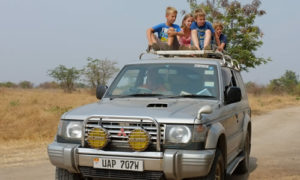 Visitors using the Kampala Mbarara highway often use the Katunguru Mweya route in the northern part of the park to get to Ishasha. This route is shorter but very unreliable during the wet season. The route is also used by heavy trucks that leave the road muddy and with potholes. When using this route, it is important to be in touch with the park offices to see if the route is passable.
Visitors using the Kampala Mbarara highway often use the Katunguru Mweya route in the northern part of the park to get to Ishasha. This route is shorter but very unreliable during the wet season. The route is also used by heavy trucks that leave the road muddy and with potholes. When using this route, it is important to be in touch with the park offices to see if the route is passable.
It is possible to travel with a private vehicle but international visitors may need to hire a car or use the reliable services of a tour operator/company. The vehicle must be a 4X4 because the roads in this remote section of the park are not very good and can be dusty or muddy depending on the season of the year. The park authorities do their best to maintain the rough roads but heavy rains damage several sections of the road.
Visitors arranging their own safari need to hire a guide or move with a park ranger to help with choosing the right routes and locating the lions. Once you spot a group of individuals, prepare to see them resting on the trees lazily as they look out at herds of grazing antelopes. Their stomachs are usually full (the previous nights meal) with some struggling to position themselves in the tree branches. The lions are not as agile as leopards and you will probably spot some individuals struggling to balance as they climb or descend down the trees. On a good day it is possible to see up to 16 lions hanging on the same tree branches. You may want to read about gorilla trekking in the Volacanoes National park in Rwanda and the 1 Day Rwanda gorilla Tour in particular.
The best time to visit Ishasha
Queen Elizabeth National Park and the Ishasha sector are open to visitors on a Uganda safari throughout the year. The dry season (April, June and July) is considered the peak season for tourists in Uganda. This season is perfect for a safari because the park is less muddy and the lions are easier to locate. The months of April, May, October and November are the rainy seasons and are more ideal for bird-watching. Please check out our 11 days Uganda Wildlife safari package if you want to combine a game drive in Ishasha with other activities like the gorilla habituation experience in Bwindi or even Rwanda safaris.
Other things to do within the Ishasha sector and Queen Elizabeth National park
The Ishasha plains of Queen Elizabeth National Park are known for the tree climbing lions but there are several other activities that one can get involved in while there.
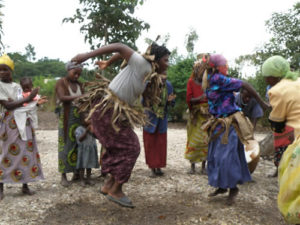 Cultural Visits: While in Ishasha, one can request for a tour of the local Bakiga community. The Ishasha community uplift program introduced a tour opportunity led by a lady Agartha. Agartha and her female friends will share with you information about the Bakiga culture and way of life. You will be taken to local homesteads and individual huts to learn the local way of preparing meals (millet porridge, bananas etc). You can go with the women to their gardens and help harvest millet, grind it into flour and turn it into a ready meal. Agartha and her group of women will share with you what it means to be a wife among the Bakiga and how to take care of the husband. By the end of the tour you would have learnt a lot about the Bakiga culture and even tasted some of their potent local brew.
Cultural Visits: While in Ishasha, one can request for a tour of the local Bakiga community. The Ishasha community uplift program introduced a tour opportunity led by a lady Agartha. Agartha and her female friends will share with you information about the Bakiga culture and way of life. You will be taken to local homesteads and individual huts to learn the local way of preparing meals (millet porridge, bananas etc). You can go with the women to their gardens and help harvest millet, grind it into flour and turn it into a ready meal. Agartha and her group of women will share with you what it means to be a wife among the Bakiga and how to take care of the husband. By the end of the tour you would have learnt a lot about the Bakiga culture and even tasted some of their potent local brew.
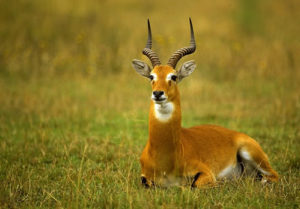 Game drive to see other animal species: The Ishasha plains are home to the Topi (type of antelope) Kobs, warthogs, buffaloes, elephants, baboons, leopards, other smaller antelopes and birds like the black coucal, compact weaver, herons and storks. You can arrange for a game drive to see some of the beautiful wildlife within the Ishasha sector. If you have more time to spare, you can decide to go for a game drive at the Kasenyi plains/sector to see more lions (do not climb trees), the beautiful Kyambura gorge is for chimpanzee trekking or the Maramagambo forest for nature walks. If you have time, do not fail to take a boat tribe around the Kazinga Chanel for one of the largest collection of wildlife and birds in the world. You might want to check out our 10 days Uganda tour package which includes a gorilla safari and visiting the best national parks in Uganda.
Game drive to see other animal species: The Ishasha plains are home to the Topi (type of antelope) Kobs, warthogs, buffaloes, elephants, baboons, leopards, other smaller antelopes and birds like the black coucal, compact weaver, herons and storks. You can arrange for a game drive to see some of the beautiful wildlife within the Ishasha sector. If you have more time to spare, you can decide to go for a game drive at the Kasenyi plains/sector to see more lions (do not climb trees), the beautiful Kyambura gorge is for chimpanzee trekking or the Maramagambo forest for nature walks. If you have time, do not fail to take a boat tribe around the Kazinga Chanel for one of the largest collection of wildlife and birds in the world. You might want to check out our 10 days Uganda tour package which includes a gorilla safari and visiting the best national parks in Uganda.
The future of tree climbing lions in Ishasha
The tree climbing lions of Ishasha are in danger of extinction. The greatest threat to the lions comes from humans living near the park. Only recently about 11 lions were found dead as a result of poisoning. It is suspected that the lions were poisoned by pastoralists who had lost their domestic animals to the lions. The communities living near the park sometimes lead their animals into the park during the dry season in search of water and grass. Lions and other park animals also frequently wander outside park boundaries eventually coming into contact with human communities. The big cats find domestic animals very attractive and easier to catch especially during the dry season and when thrown out of the pride. When they lose an animal to the lions, some individuals within the communities have resorted to setting up traps/snares and poison for the big cats.
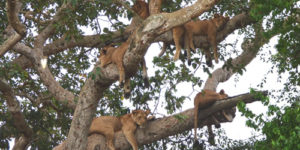 The Uganda Wildlife Authority (UWA) has tried hard to ensure that there is a harmonious relationship between the communities living near the park and the park animals. UWA strives to ensure that the communities benefit economically from tourism through direct employment and giving back 20 percent of the money earned from tourism to the community. The park also compensates the locals whenever they lose their livestock to the lions and arranges for community sensitization meeting about the importance of the lions to the people and posterity. The Uganda Carnivore Project introduced lion tracking in Queen Elizabeth national park to help raise funds for lion conservation. You might want to find out more about our Uganda gorilla tour packages and how to make booking from our contact us page.
The Uganda Wildlife Authority (UWA) has tried hard to ensure that there is a harmonious relationship between the communities living near the park and the park animals. UWA strives to ensure that the communities benefit economically from tourism through direct employment and giving back 20 percent of the money earned from tourism to the community. The park also compensates the locals whenever they lose their livestock to the lions and arranges for community sensitization meeting about the importance of the lions to the people and posterity. The Uganda Carnivore Project introduced lion tracking in Queen Elizabeth national park to help raise funds for lion conservation. You might want to find out more about our Uganda gorilla tour packages and how to make booking from our contact us page.
Where to stay while visiting the tree climbing lions
Although there are several good accommodation facilities available for visitors within Queen Elizabeth National Park, the ones in Ishasha are few. Booking in advance with your tour operator in Uganda is highly recommended especially during the peak seasons like June. Let’s look at two of the more popular lodges in Ishasha.
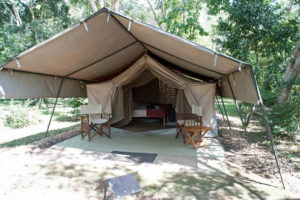 Ishasha Wilderness Camp: This facility is suitable for travelers who desire to be close to nature and experience what it is like to live in the wild bushes of Africa. The camp is built on the banks of River Ntungwe – an area that is quiet remote and relatively unspoiled. The camp offers 10 luxury tents with beautiful interiors, warm shower, clean toilets and new mosquito nets. The tents face the river enabling one to see some of the park animals (elephants, hippos, antelopes and small primates) come to bath and drink by the river banks. Vervet and Colobus monkeys are frequent visitors to the camp and can be seen swinging on nearby trees close to the compound. Meals can be served either in the rooms or in a beautifully set up dining area on the river banks. The camp prepares food that can be packed for those leaving the rooms for activities within the Ishasha plains. Residents have an opportunity to meet by the camp fire in the evening as they share stories about their adventures in Uganda.
Ishasha Wilderness Camp: This facility is suitable for travelers who desire to be close to nature and experience what it is like to live in the wild bushes of Africa. The camp is built on the banks of River Ntungwe – an area that is quiet remote and relatively unspoiled. The camp offers 10 luxury tents with beautiful interiors, warm shower, clean toilets and new mosquito nets. The tents face the river enabling one to see some of the park animals (elephants, hippos, antelopes and small primates) come to bath and drink by the river banks. Vervet and Colobus monkeys are frequent visitors to the camp and can be seen swinging on nearby trees close to the compound. Meals can be served either in the rooms or in a beautifully set up dining area on the river banks. The camp prepares food that can be packed for those leaving the rooms for activities within the Ishasha plains. Residents have an opportunity to meet by the camp fire in the evening as they share stories about their adventures in Uganda.
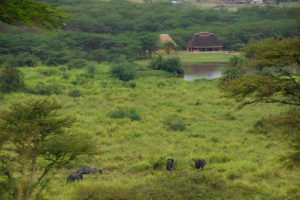 Enjojo Lodge: Enjojo Lodge offers both mid-range and luxury facilities. The lodge was built with local material in order to give that feeling of being in the African wilderness. All decorations are crafted by local artists – many of whom come from nearby communities. The cottages offer enough comfort to allow you relax as you look forward to the next day’s activities within the sector. While at the lodge residents can spot animals roaming freely inside the 40 acre property. Among the activities available for residents in Enjojo lodge are fishing (tilapia, catfish and lungfish) at the lake Akanyanza.
Enjojo Lodge: Enjojo Lodge offers both mid-range and luxury facilities. The lodge was built with local material in order to give that feeling of being in the African wilderness. All decorations are crafted by local artists – many of whom come from nearby communities. The cottages offer enough comfort to allow you relax as you look forward to the next day’s activities within the sector. While at the lodge residents can spot animals roaming freely inside the 40 acre property. Among the activities available for residents in Enjojo lodge are fishing (tilapia, catfish and lungfish) at the lake Akanyanza.

How many tree climbing lions are there in the park now?